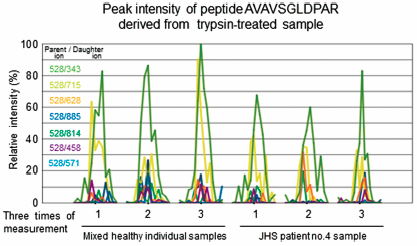- 著者
- Kazuo Yamada Atsushi Watanabe Haruo Takeshita Atsushi Fujita Noriko Miyake Naomichi Matsumoto Ken-ichi Matsumoto
- 出版者
- The Pharmaceutical Society of Japan
- 雑誌
- Biological and Pharmaceutical Bulletin (ISSN:09186158)
- 巻号頁・発行日
- vol.42, no.9, pp.1596-1599, 2019-09-01 (Released:2019-09-01)
- 参考文献数
- 15
- 被引用文献数
- 5 5
Joint hypermobility syndrome (JHS) (also termed hypermobility type Ehlers–Danlos syndrome, hEDS) is a heritable connective tissue disorder that is characterized by generalized joint hypermobility, chronic pain, fatigue, and minor skin changes. Initially, it was reported that there is a small subset of patients with JHS/hEDS who have haploinsufficiency of tenascin-X (TNX). However, the relationship between TNXB and JHS/hEDS has not been reported at all afterwards. EDS was reclassified into thirteen types in 2017, and the causative gene of JHS/hEDS remained to be identified. Therefore, in this study in order to determine whether JHS/hEDS can be diagnosed by the concentrations of serum form of TNX (sTNX), we measured the concentrations of sTNX in 17 JHS/hEDS patients. The sTNX concentrations in half of the JHS/hEDS patients were significantly lower than those in healthy individuals. No mutations, insertions or deletions were detected in the TNX exon sequence of the JHS/hEDS patients except for one in patient. That patient has a heterozygous mutation. A correlation between sTNX concentration and mutation of the TNXB genomic sequence was not found in the JHS/hEDS patients. These results indicate that the decrease in sTNX concentration could be used as a risk factor for JHS/hEDS.
言及状況
外部データベース (DOI)
Twitter (8 users, 9 posts, 11 favorites)
Sometimes we need to look further than our own academic culture and notice what others are doing. #EDS #hEDS #HSD https://t.co/gCK1k7EEd5
Although hypermobile Ehlers-Danlos syndrome is regarded as a genetic condition, the underlying cause has not been identified. Biol Pharm Bull. 2019; 42(9):1596-1599.
#EDS #HEDS #invisibledisability #genetic #heritible #invisiblepain @loosefacts
https://t.co/CEYzyX4fbe.
Although hypermobile Ehlers-Danlos syndrome is regarded as a genetic condition, the underlying cause has not been identified. Biol Pharm Bull. 2019; 42(9):1596-1599. #HEDS #invisibledisability #myEDSchallenge #myHSDchallenge @loosefacts @elhers.danlos https://t.co/ybqPkuhffc. https://t.co/vOkp1MswQs
"The sTNX concentrations in half of the JHS/hEDS patients were significantly lower than those in healthy individuals....[But NO TNXB mutations!] These results indicate that the decrease in sTNX concentration could be used as a risk factor for JHS/hEDS."
https://t.co/6slFRuWy1e
In Hypermobility Joint condtns #EhlersDanlos approx HALF of subjects have LOW serum levels of TENASCIN X, a matrix glycoprotein, with no a mutation. This suggests an epigenetic problem (inadequate gene expression). Matrix disorders are more than collagen https://t.co/AgoVbmElZe https://t.co/TcPlpJTJd5
https://t.co/lXQCk4wKhf
Measurement of Serum Tenascin-X in Joint Hypermobility Syndrome/Hypermobile Ehlers Danlos Patients - should a decrease in serum TNX be used as a risk factor for JHS/hEDS?
